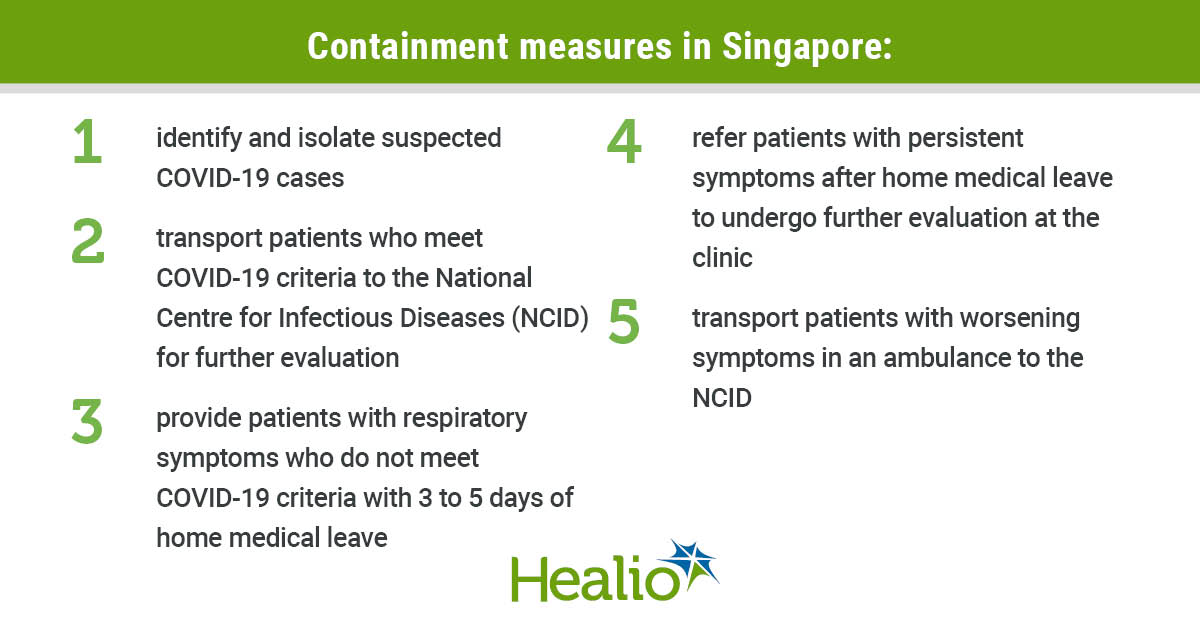Front-line physicians outline primary care strategies in Singapore to limit COVID-19 spread


Two primary care physicians in Singapore outlined containment and infection control strategies that a network of general practitioner clinics in the country used to prevent the spread of COVID-19. The framework was published in Annals of Family Medicine.
“It is our hope that our experience may contribute towards a framework which other health care systems may adapt to their unique needs,” Wei Han Lim, MBBS, and Wei Mon Wong, MBBS, FCFP, both of the division of primary care at Raffles Medical Group in Singapore, wrote. “Moving forward, we envision that our experience would prompt more widespread examination of the role of primary health care in pandemics such that globally, primary health care networks may mount prompt and effective evidence-based responses.”
Singapore has been lauded for its COVID-19 efforts in public health and containment, according to the authors. The country is “heavily reliant” on its network of primary health care clinics, which are “the cornerstone of early identification and isolation” of suspected COVID-19 cases, they wrote.
Containment measures
In a network of 50 general practices, health care workers contained COVID-19 by streamlining visits based on a “fixed protocol” that required:
- reception area nurses to identify and triage suspected COVID-19 cases;
- promptly isolating patients with respiratory tract symptoms until clinician assessment;
- transporting patients who met COVID-19 criteria to the country’s National Centre for Infectious Diseases (NCID) for further evaluation;
- providing patients with an upper respiratory tract infection, but not COVID-19, with 3 to 5 days of home medical leave and using the network’s electronic medical records system to flag these patients for follow-up;
- counseling patients who reported persistent symptoms after home medical leave to undergo further testing at the clinic;
- recommending patients whose symptoms progressed during leave to consult with a physician; and
- transporting patients with worsening symptoms in an ambulance to the NCID for additional evaluation.
“These measures worked in concert with government containment measures such as mandatory 14-day stay-home restriction on returning travelers from high-risk regions of the world,” Lim and Wong wrote.

Infection control measures
To avoid cross-contamination:
- medical staff were immediately updated on new developments through multiple communication channels, including email and secure mobile chat groups;
- training was enforced through one-one-one sessions and multimedia information guides;
- medical staff were instructed on how to appropriately use and dispose of personal protective equipment (PPE);
- patients were managed based on directives from the Ministry of Health;
- PPE guidelines were enforced among physicians, nurses and reception staff; and
- clinics with suspected cases of COVID-19 were closed for decontamination.
There were 56,820 patient visits across the general practices between Feb. 8 and Feb. 22, Lim and Wong wrote. Of that total, 125 were escorted to the NCID and three tested positive for COVID-19. There were no cases reported among health care workers within the network during this time, according to the authors.
‘Unique challenges’
NPR reported that in April, COVID-19 cases in Singapore increased from fewer than 600 to more than 17,000. Most of the new cases originated from overcrowded dormitories that house about one-third of the country’s migrant population, according to the report.
Lim and Wong told Healio Primary Care that their approach to containing and controlling COVID-19 remains the same regardless of the increase in cases reported by NPR.
They added that the NPR report provides evidence that approaches to fighting COVID-19 should be tailored to the situation.
“Each country will have its own unique challenges and may respond differently while taking into account best practices elsewhere,” Lim said. “For Singapore, what works and remains so is testing, tracing and containment underlaid with honest communication and organized leadership at the national level.”
They added that outside the crammed migrant housing areas, the number of COVID-19 cases is “trending down toward single digits.” – by Janel Miller
References:
Beaubien J. Singapore was a shining star in COVID-19 control — until it wasn’t. NPR. May 3, 2020. https://www.npr.org/sections/goatsandsoda/2020/05/03/849135036/singapore-was-a-shining-star-in-covid-control-until-it-wasnt. Accessed May 11, 2020.
Lim WH, Wong WM. Ann Fam Med. 2020;doi:10.1370/afm.2539.
Disclosures: The authors report no relevant financial disclosures.


